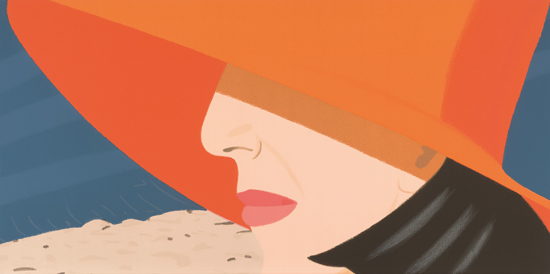One Cool Katz
Alex Katz’s prints at the MFA

Orange Hat, from the portfolio Alex and Ada, 1960s to 1980s, 1990. Photos courtesy of the Museum of Fine Arts, Boston
Alex Katz Prints, an exuberant celebration of New York-based artist Alex Katz’s career as a printmaker (he is also a noted painter), is the current show at the Museum of Fine Arts. Saturated with color, Katz’s prints have a bold, graphic quality and display his mastery of various printing techniques. The 84-year-old artist is equally at home in aquatint, screen print, lithograph, Japanese woodcut techniques, or linoleum cuts.
Katz’s work, influenced by advertising billboards, the extreme close-ups popularized by 1960s television shows, and the large-scale panorama of 1950s movie screens, returns again and again to his fascination with fashion, dance, and poetry.

The exhibition includes more than 100 works drawn from the collections of the Albertina Museum, in Vienna, where the show originated, and the Museum of Fine Arts, which began acquiring the artist’s prints in the 1970s.
Many of the prints on display depict Katz’s friends and family. His son, Vincent, and daughter-in-law, Vivienne, are the subject of several, and a number of self-portraits are included. In one, dated 1978, Katz wittily imagines himself as a slick Hollywood celebrity, tanned and with a mouthful of gleaming white teeth. And in what is arguably the most ambitious part of the show—an installation called Rush (1971)—he depicts 37 dancers, poets, critics, artists, and family members who were part of his social circle in New York and Maine, where he has summered for more than 50 years. The portraits here are not prints, but oil paintings on sheets of aluminum, cut into the shape of each individual’s head and shoulders. Katz says the installation’s title was inspired by the “buzz, or rush of adrenaline” one might get from seeing so many familiar faces all in one place.

Nowhere is the sense of familial intimacy stronger than in the dozens of prints depicting Katz’s wife and artistic muse, Ada. The two met at a gallery opening in 1957 and have been together ever since. In works like Orange Hat (1990), Red Coat (1983), and Reclining Figure/Indian Blanket (1987), Ada is portrayed as stylish and glamorous, eyes heavily lidded, lips painted an alluring red, chiseled patrician features—in short, a figure to be reckoned with. In the show, Katz describes her as “a great beauty,” whose “gestures are perfect.” It’s easy to see what he means. The way she tilts her head, drapes a scarf across her shoulders, or stares languidly out from behind aviator sunglasses conveys a regal presence.
Katz’s playfulness comes across in his cutouts, like Cow (2006), which he began making in 1959, cutting out and mounting onto plywood figures he’d discarded from his paintings.
His landscapes—most inspired by the trees and lakes and summer skies of his beloved Maine, reveal his preoccupation with light and shadow, reflection and silhouette. In the magnificent Twilight (1978), a series of three-color screen prints, Katz captures the same—or nearly identical—landscape at different intervals of sunset. In each print, the sky is rendered in various shades of blue, pink, and violet, underscoring his interest in capturing fleeting light. In the exhibition’s accompanying audio, Katz says he often had only 15 minutes to paint these sunsets before darkness made it impossible.
Other landscapes explore color and tint. In two lithographs, Swamp Maple 1 and Swamp Maple 2, both from 1970, a lone swamp maple is in the foreground against a background of water and hills—but with vastly different results. In the first, the colors are vivid, in the second the palette is much more subdued and monochromatic. So too with the two prints Good Afternoon (1974) and Good Afternoon 2 (1975). In both, a woman in a rowboat heads to the opposite shore. Where the first lithograph is all vibrant greens and blues, the second is rendered in shades of gray, gray-blue, and olive green.

Katz has always been in some ways a loner. At a time when nearly all of his contemporaries gravitated toward abstractionism, he embraced figurative painting. The show is arranged thematically rather than chronologically, giving viewers an opportunity to see how the artist returned again and again to certain ideas and subjects.
Alex Katz Prints is on display at the Museum of Fine Arts, 465 Huntington Ave., Boston, through Sunday, July 29. The museum is open Monday, Tuesday, Saturday, and Sunday from 10 a.m. to 4:45 p.m., and Wednesday through Friday from 10 a.m. to 9:45 p.m. Admission is free with a BU student ID, $20 for seniors and students 18 and older, $22 for adults, and free for children 6 and under; free to the public on Wednesday evenings. By public transportation, take the Green Line E trolley or the number 39 bus to the Museum of Fine Arts stop or the Orange Line train or bus routes 8, 47, or C2 to the Ruggles stop.

Comments & Discussion
Boston University moderates comments to facilitate an informed, substantive, civil conversation. Abusive, profane, self-promotional, misleading, incoherent or off-topic comments will be rejected. Moderators are staffed during regular business hours (EST) and can only accept comments written in English. Statistics or facts must include a citation or a link to the citation.